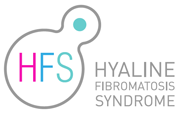Clinical description
The first medical description of HFS goes back to 1903, by Whitfield and Robinson (1). Over the years, the disease had multiple denominations starting with Molluscum Fibrosum, then Juvenile Hyaline Fibromatosis and Infantile Systemic Hyalinosis (ISH) (2, 3). But in 1991 a unifying term has been adopted, since the former denominations were just various manifestations of the same disease (4).
Over 150 medical cases have been reported, with no ethnical or geographical specificity.
The onset of the disease usually varies between birth and early childhood. The symptoms are disabling and disfiguring, with the connective tissues severely affected. The disease name refers to the accumulation of a transparent amorphous (glass-like) material under the patient skin and in other organs (5, 6, 7).
Patients present flexural contracture of the large joints, usually accompanied of thickening of the skin. Reduced movement will then lead to a poor muscle development and a characteristic frog-legged position, even if the affected newborns do not show gross morphological defects.
The patients affected by the most severe form of the disease present an increased susceptibility to bone fracture, chest infection and diarrhea. Mental development, hearing and eyesight seem to be unaffected.
Nodules are the most striking external features and are a hallmark of the disease. They are described in more details in another section.
(1) Whitfield and Robinson, 1903 (2) Drescher et al, 1967 (3) Landing and Nadorra, 1986 (4) El Kamah, 2010 (5) Landing and Nadorra, 1986 (6) Fayad et al, 1987 (7) Keser et al, 1999




